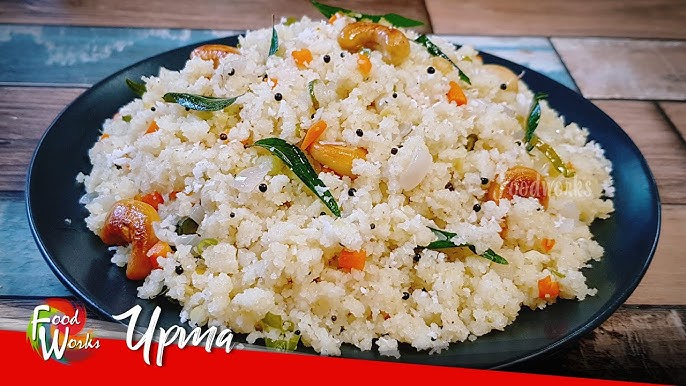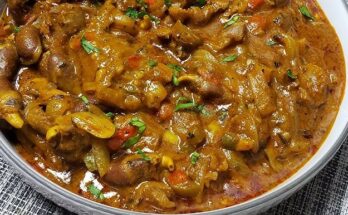Upma Recipe: Upma is one of those comfort foods that has stood the test of time in Indian households. It’s quick, easy, wholesome, and downright delicious. Made primarily from semolina (also called rava or suji), this South Indian staple is a favorite for breakfast but can be enjoyed any time of the day. Upma is known for its soft, fluffy texture and savory taste, enhanced with tempering spices, veggies, and a hint of lemon.
The roots of Upma lie in Southern India, but it has gracefully found its way into the hearts of people across the country. It’s not just a dish—it’s a symbol of simplicity and nourishment. In fact, you’ll find as many variations of Upma as there are households in India, each with its unique touch. Whether you like it plain with just mustard seeds and curry leaves or loaded with vegetables and nuts, Upma offers the perfect canvas for your creativity.
Ingredients Required for Upma
The beauty of Upma lies in its simplicity. You don’t need a long list of ingredients to make a hearty bowl of Upma. Here’s what you’ll need:
Basic Ingredients
- 1 cup semolina (rava/suji)
- 2 tablespoons oil or ghee
- 1 teaspoon mustard seeds
- 1 teaspoon urad dal (optional)
- 1 teaspoon chana dal (optional)
- 1-2 green chilies, finely chopped
- 1 sprig curry leaves
- 1 medium onion, finely chopped
- Salt to taste
- 2 to 2.5 cups water
- Lemon juice (optional)
- Fresh coriander leaves for garnishing
Optional Vegetables and Spices
- 1/4 cup carrots, finely chopped
- 1/4 cup green peas
- 1/4 cup beans, finely chopped
- A pinch of asafoetida (hing)
- Ginger, grated or chopped
- Cashew nuts for added richness
These ingredients are flexible, which means you can customize them based on what’s available in your kitchen. The core component—semolina—remains the same, but the add-ons can vary widely depending on taste preferences and dietary needs.
Preparation Before Cooking
Great Upma starts with proper preparation. If you rush through this phase, you might end up with lumpy or undercooked semolina. Let’s take a few moments to prep everything perfectly.
Roasting Rava/Semolina
Start by roasting 1 cup of rava in a dry pan on medium heat. Stir continuously to avoid burning and ensure even roasting. You’ll know it’s done when the rava turns light golden and gives off a nutty aroma. Set it aside to cool. This step is crucial for achieving a non-sticky, fluffy texture.
Chopping Vegetables
Finely chop onions, carrots, beans, and any other veggies you’re using. Thinly slicing green chilies and grating a bit of ginger also helps infuse better flavor. You want the vegetables to be small so they cook quickly and evenly.
Setting Up Cooking Station
Once all ingredients are prepped, arrange them near your stove. Have water measured and kept ready to pour. Cooking Upma requires adding rava at just the right moment, so you don’t want to be fumbling with ingredients during the process.
Step-by-Step Upma Cooking Instructions
Let’s dive into the actual cooking process. Follow these steps carefully, and you’ll end up with a bowl of perfect, fluffy Upma.
Step 1 – Heat Oil and Temper Spices
Heat 2 tablespoons of oil or ghee in a thick-bottomed pan. Add mustard seeds and let them splutter. Then add urad dal and chana dal if you’re using them. Fry until the dals turn golden. Now, throw in chopped green chilies, ginger, and curry leaves. Stir for a few seconds until fragrant.
This tempering forms the flavor base of your Upma. It’s a crucial step, so don’t skip or rush it. Let the aroma fill your kitchen before moving to the next step.
Step 2 – Add Vegetables
Next, add chopped onions and sauté them until translucent. Then toss in all the chopped vegetables—carrots, peas, beans, etc. Sauté for about 3-4 minutes. The idea is not to brown them but to slightly soften them so they continue cooking when you add water.
If you like a spicier Upma, now’s a good time to sprinkle in a pinch of black pepper or red chili flakes. Keep stirring to prevent sticking and ensure even cooking.
Step 3 – Add Water and Boil
Pour in 2 to 2.5 cups of water, depending on the consistency you prefer. Add salt to taste. Stir well, cover the pan, and bring the mixture to a boil. This step is critical for ensuring your rava cooks thoroughly and absorbs all the flavor.
Once the water comes to a rolling boil, lower the heat to a simmer. Taste the water for salt—this is your last chance to adjust before adding the rava.
Step 4 – Add Roasted Rava Slowly
This is the most crucial part of making perfect Upma. Once the water is boiling and well-seasoned, start adding the roasted rava slowly and steadily, stirring continuously with your other hand. You need to ensure the rava is incorporated evenly into the hot water to avoid forming lumps.
Don’t dump all the rava at once—it will create big clumps that are very hard to fix. Stirring continuously allows the rava to absorb water gradually, giving you that soft, fluffy texture Upma is known for. This step requires your full attention for at least 2-3 minutes until all the rava is mixed in and there are no dry spots or clumps.
If you notice any lumps, break them up immediately with the back of your spoon or spatula. Keep the heat on low throughout this process to prevent the bottom from burning.
Step 5 – Stir and Steam
Once the rava is fully mixed in and starting to thicken, cover the pan with a lid and let it steam on low heat for about 3-4 minutes. This allows the semolina to absorb the remaining water and cook through completely.
After the steaming is done, open the lid and give it a good final stir. You’ll notice the Upma has thickened and fluffed up. Add a drizzle of ghee or a squeeze of lemon juice for that final touch of richness and brightness. Garnish with chopped coriander leaves and roasted cashews if desired.
And voila! Your delicious, homemade Upma is ready to serve hot.
Tips for Perfect Upma
Even though Upma is a simple dish, a few handy tips can elevate your dish from average to amazing.
1. Always roast the rava properly
Under-roasted rava leads to sticky or pasty Upma. Make sure it’s lightly golden and aromatic before using.
2. Use the right water ratio
The ideal water-to-rava ratio is usually between 2:1 and 2.5:1. For a softer texture, use more water. For firmer Upma, use slightly less.
3. Stir continuously while adding rava
This avoids lumps and helps the semolina cook evenly.
4. Don’t rush the steaming
Letting it sit covered allows the rava to fluff up perfectly.
5. Customize your veggies and spices
Feel free to experiment with ingredients like bell peppers, tomatoes, or even corn. You can also add a pinch of garam masala or sambar powder for extra flavor.
Serving Suggestions
Upma is best served hot and fresh. It makes for a satisfying breakfast, a light lunch, or even a comforting dinner on lazy days. Here’s how you can serve it:
- With coconut chutney – The cool, creamy texture pairs wonderfully with the warm, spicy Upma.
- With pickle or curd – A tangy pickle or a bowl of plain yogurt adds a great contrast.
- With tea or coffee – A classic South Indian breakfast pairing.
If you’re hosting guests, garnish your Upma with roasted cashews, grated coconut, or even a few fried curry leaves for that restaurant-style presentation.
Nutritional Value of Upma
Upma isn’t just tasty—it’s also quite nutritious, making it an ideal choice for a wholesome meal. It’s low in fat, easy on the stomach, and provides a decent amount of energy to start your day right.
Calories and Macronutrients
A standard serving (around 1 cup) of plain vegetable Upma contains approximately:
- Calories: 180–220 kcal
- Carbohydrates: 35–40g
- Protein: 4–6g
- Fat: 5–8g (depending on oil or ghee used)
- Fiber: 2–3g
These values can vary based on the vegetables added and the amount of oil or ghee used in preparation. Adding nuts like cashews slightly increases the fat content but also adds good fats and protein.
Health Benefits
- Rich in Iron & Magnesium: Semolina is naturally high in iron and magnesium, helping improve blood circulation and muscle function.
- Low Glycemic Index: When paired with vegetables and moderate oil, Upma can have a low glycemic index, making it suitable for diabetics in moderation.
- Good Source of Energy: The complex carbs in semolina release energy slowly, keeping you full and energized for longer.
Upma can also be made healthier by switching up the core ingredient—like using oats, millet, or broken wheat instead of regular semolina.
Variations of Upma
One of the reasons Upma is so beloved across India is its versatility. You can give it a new twist each time just by tweaking a few ingredients.
1. Vegetable Upma
This is the most common version, made with a mix of seasonal vegetables like carrots, beans, and peas. It’s colorful, nutritious, and more filling.
2. Tomato Upma
Add finely chopped tomatoes after sautéing the onions. Let them cook until soft and mushy. This gives the dish a tangy flavor and a vibrant red hue.
3. Millet or Broken Wheat Upma
For a healthier version, replace rava with foxtail millet, barnyard millet, or broken wheat (dalia). These grains are high in fiber, more nutritious, and suitable for diabetic or weight-conscious diets.
4. Bread Upma
Instead of rava, use cubes of day-old bread tossed in the same tempering and vegetables. It’s quick, different, and a great way to use leftover bread.
5. Oats Upma
Oats provide soluble fiber, which is excellent for heart health. Simply replace semolina with rolled or quick oats and follow the same procedure.
These variations are especially useful if you’re cooking for kids or guests who like something new and fun every time.
Storage and Reheating Tips
If you’ve made a big batch of Upma or have leftovers, don’t worry—it stores quite well for a short time.
How to Store:
- Allow the Upma to cool completely before storing.
- Transfer to an airtight container and refrigerate. It stays good for up to 2 days.
- Avoid freezing, as the texture of semolina doesn’t hold up well after thawing.
How to Reheat:
- Add a tablespoon or two of water to a pan before reheating.
- Warm on a low flame while stirring continuously to regain the original fluffy texture.
- Alternatively, microwave it covered for 1-2 minutes with a splash of water.
Avoid storing Upma with too many wet vegetables or excess water, as it can become soggy.
Common Mistakes to Avoid
Even though Upma is simple to prepare, it’s easy to make a few missteps that can ruin its texture or taste.
1. Not Roasting the Rava Properly
Skipping this step is the most common mistake. Unroasted rava leads to sticky, gluey Upma. Always roast until aromatic and slightly golden.
2. Adding Rava Too Quickly
Pouring in rava all at once causes lumps. Always add slowly in a steady stream while stirring continuously.
3. Using Less Water
Not using enough water can make the Upma dry and undercooked. Stick to the 2:1 water-to-rava ratio for soft, fluffy Upma.
4. Overcooking the Vegetables
Veggies should be slightly crisp, not mushy. Overcooking kills the color, flavor, and nutrition.
5. Not Stirring Enough
Once rava is added, constant stirring is key to prevent sticking and lump formation.
By avoiding these pitfalls, you’ll get perfect results every single time.
Upma for Special Diets
Upma can easily be adapted to fit different dietary needs without compromising taste.
1. Vegan Upma
Simply use oil instead of ghee, and skip any ingredients like butter or dairy-based curd. It’s already plant-based, so this switch is easy.
2. Gluten-Free Upma
Traditional rava contains gluten, but you can make a gluten-free version by substituting with:
- Rice semolina
- Cornmeal
- Millet flour (bajra or jowar)
- Quinoa or oats (check for certified gluten-free)
Adjust water ratios slightly when using alternate grains, as they may absorb differently.
3. Low-Carb Upma
For a keto or low-carb twist, consider using grated cauliflower (“cauliflower rice”) in place of semolina. It cooks quickly and carries flavors well.
These versions let you enjoy your favorite dish while sticking to your nutritional goals.
FAQs about Upma Recipe
Q1: Why is my Upma sticky and lumpy?
A: You probably added rava too quickly or didn’t roast it properly. Always roast until aromatic and add gradually while stirring.
Q2: Can I make Upma without vegetables?
A: Absolutely! A basic version with just tempering and onions is just as delicious.
Q3: Is Upma suitable for kids?
A: Yes, it’s soft, easy to digest, and can be made more nutritious with veggies and nuts.
Q4: Can I make Upma in advance?
A: It’s best fresh, but you can make it a few hours ahead. Reheat gently with a splash of water.
Q5: What can I serve with Upma?
A: Coconut chutney, curd, pickle, or even sambhar work beautifully with Upma.
Conclusion
Upma is the ultimate Indian breakfast that checks all the boxes—quick, easy, delicious, and healthy. Whether you’re a novice cook or a seasoned chef, Upma is one of those dishes that lets you play around while still delivering comfort in every bite. Plus, with so many variations and customization options, you can enjoy a new twist every time.
So why wait? Grab that semolina, fire up the stove, and treat yourself to a warm bowl of homemade Upma.



